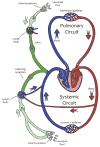Lymphatic System Flows
- PMID: 29713107
- PMCID: PMC5922450
- DOI: 10.1146/annurev-fluid-122316-045259
Lymphatic System Flows
Abstract
The supply of oxygen and nutrients to tissues is performed by the blood system, and involves a net leakage of fluid outward at the capillary level. One of the principal functions of the lymphatic system is to gather this fluid and return it to the blood system to maintain overall fluid balance. Fluid in the interstitial spaces is often at subatmospheric pressure, and the return points into the venous system are at pressures of approximately 20 cmH2O. This adverse pressure difference is overcome by the active pumping of collecting lymphatic vessels, which feature closely spaced one-way valves and contractile muscle cells in their walls. Passive vessel squeezing causes further pumping. The dynamics of lymphatic pumping have been investigated experimentally and mathematically, revealing complex behaviours indicating that the system performance is robust against minor perturbations in pressure and flow. More serious disruptions can lead to incurable swelling of tissues called lymphœdema.
Keywords: Cancer; Immunology; Lymph; Oedema; Physiology.
Figures








References
-
- Adair TH, Guyton AC. Modification of lymph by lymph nodes. II. Effect of increased lymph node venous blood pressure. American Journal of Physiology (Heart Circ Physiol ) 1983;245:H616–H22. - PubMed
-
- Adair TH, Guyton AC. Modification of lymph by lymph nodes III. Effect of increased lymph hydrostatic pressure. American Journal of Physiology (Heart Circ Physiol ) 1985;249:H777–H82. - PubMed
-
- Allanson JE. Lymphatic System. In: Stevenson RE, Hall JG, editors. Human Malformations and Related Anomalies. 2. New York: Oxford University Press; 2005. pp. 145–82.
-
- Aukland K, Reed RK. Interstitial-lymphatic mechanisms in the control of extracellular fluid volume. Physiological Reviews. 1993;73:1–78. - PubMed
Grants and funding
LinkOut - more resources
Full Text Sources
Other Literature Sources
